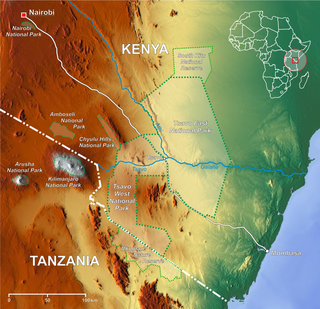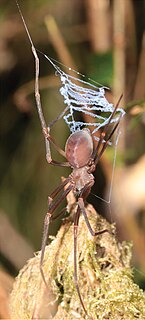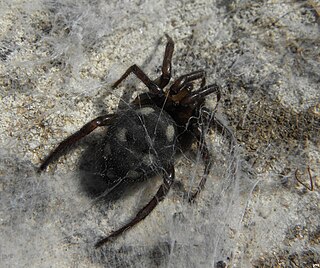| Oecobius amboseli | |
|---|---|
| Scientific classification | |
| Kingdom: | Animalia |
| Phylum: | Arthropoda |
| Subphylum: | Chelicerata |
| Class: | Arachnida |
| Order: | Araneae |
| Infraorder: | Araneomorphae |
| Family: | Oecobiidae |
| Genus: | Oecobius |
| Species: | O. amboseli |
| Binomial name | |
| Oecobius amboseli Shear & Benoit, 1974 | |
Oecobius amboseli is a species of wall spider in the family Oecobiidae. [1] [2] [3] [4] It is found in Egypt, Ethiopia, Kenya, Uganda, and Rwanda. It is an invasive species in Denmark, Netherlands, and Belgium. [5]

Wall spider is the common name for members of the genus Oecobius. The members of these several species are all very small spiders that make small flat webs over crevices in walls and in similar spaces. They possess an organ called a cribellum, which is a kind of comb-like device used to separate fibers of silk drawn from its spinnerets into many extremely fine fibers. Those fibers are so small in diameter that prey insects easily become entangled in them. The spiders then bite them before they can get away.

Oecobiidae, also called disc web spiders, is a family of araneomorph spiders, including about 100 described species. They are small to moderate sized spiders (about 2 to 20 millimetres long combined head and body length, depending on the species. Larger ones tend to be desert-dwelling. The legs are unusually evenly placed around the prosoma; most other spiders have some legs directed clearly forward and the rest clearly backward, or all forward. The first two pairs of legs of many Oecobiids point forward then curve backwards; somehow in a running spider this gives a curiously scurrying, wheel-like impression that is characteristic of many Oecobiidae, and is helpful as a rough-and-ready aid to identification in the field. Characteristic of the family is the anal gland; it bears a tuft of long hairs. Typical colour patterns range from dark-patterned cream in some smaller species, to a small number of symmetrically-placed, conspicuous round light spots on a background that may be anything from a dull orange colour to black. The carapace is rounded and bears a compact group of six to eight eyes medially situated near the front of its dorsal surface.

Egypt, officially the Arab Republic of Egypt, is a country in the northeast corner of Africa, whose territory in the Sinai Peninsula extends beyond the continental boundary with Asia, as traditionally defined. Egypt is bordered by the Gaza Strip and Israel to the northeast, the Gulf of Aqaba and the Red Sea to the east, Sudan to the south, Libya to the west, and the Mediterranean Sea to the north. Across the Gulf of Aqaba lies Jordan, across the Red Sea lies Saudi Arabia, and across the Mediterranean lie Greece, Turkey and Cyprus, although none share a land border with Egypt.





